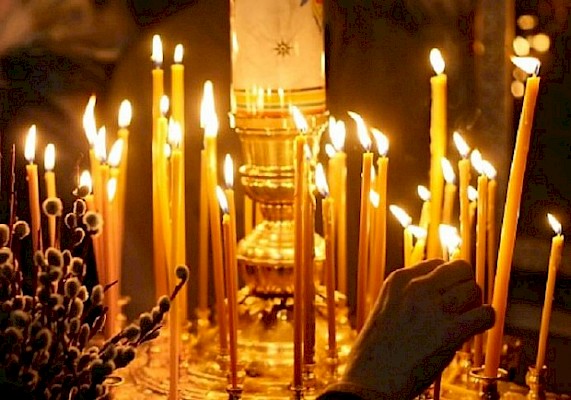St.George Russian Orthodox Church
The Candle

What does a person first do upon crossing the threshold of a church? In nine out of ten cases, he goes to the candle stand. Our practice of Christianity, our involvement in its ritual, begins with a little beeswax candle. It is impossible to imagine an Orthodox church in which candles are not lit.
Blessed Simeon of Thessalonica (15th century), commentator on the Liturgy, states that pure wax symbolizes the purity and chastity of those who offer it. It is offered as a sign of our having repented of stubbornness and self-will. The softness and pliability of wax speaks of our readiness to obey God. The burning of the candle represents man's deification, his becoming a new creature through the fire of God's love.
Moreover, the candle is a witness to faith, of man's belonging to the Divine light. It expresses the flame of our love for the Lord, for the Mother of God, for the angels, or for the saints. One must not light a candle with a cold heart, merely as a formality. The external action must be supplemented by prayer, if only the simplest one, using one's own words.
A lighted candle is present at many church services. It is held by the newly baptized and by those being joined together in the Mystery of Matrimony. The funeral rite is performed amidst a multitude of burning candles. Protecting their burning candles from the wind, the faithful walk in Processions of the Cross.
There are no absolute rules as to where or how many lighted candles must be offered. Their purchase is a little sacrifice to God, voluntary and not burdensome. A large and expensive candle is no more grace-giving than is a small one.
Those who are meticulous about attending church try to light several candles during each visit: before the festal icon at the center of the church, at the icon of the Savior or of the Mother of God; for the health of their loved ones, and on the rectangular candlestand (kanun) before the Cross; for the repose of the souls of the deceased. If the heart so wishes, one may light candles to any saint or saints.
Sometimes it so happens that all of the spaces on the candlestand are filled, leaving no place to set a lighted candle. One should not extinguish an already-burning candle and replace it with one's own. It is better to ask one of the attendants to light it for you at an appropriate moment. One should not be upset if, at the end of the Service, your candle is extinguished; the sacrifice has already been accepted by God.
There is no reason to believe talk that one should set a candle only with the right hand, that if it should go out, it is a sign misfortune will follow, that to singe the base of the candle to make it fit more firmly into the receptacle is a deadly sin, etc. There are many such superstitions, and they are all meaningless.
The burning wax candle is pleasing to God, but He prizes the burning of the heart even more. Our spiritual life, our participation in church services, is not limited to the candle. The candle will not free us from sin, will not unite us with God, and will not give us the power to wage the unseen warfare. The candle is filled with symbolic meaning, but we are saved not by symbols, but by the full reality, Divine grace.
From the book Fundamentals of Orthodoxy
